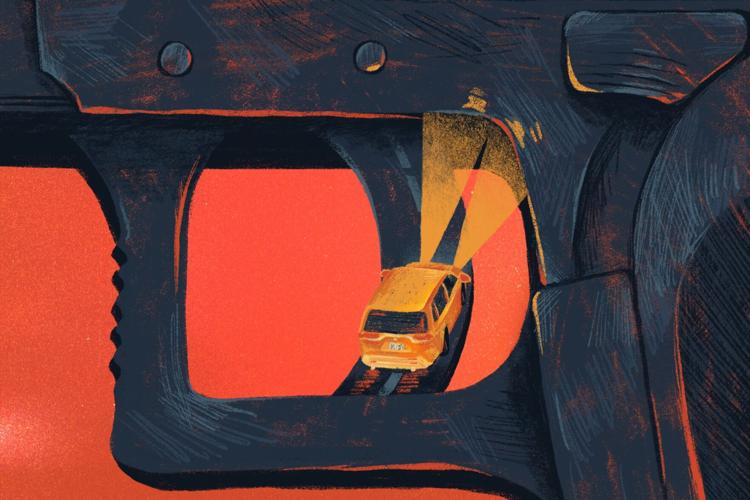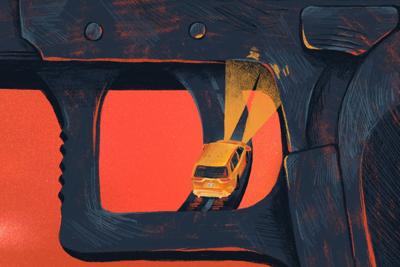Canada doesn’t often serve as a foreign writer’s muse; indeed, even Canadian writers often look elsewhere for inspiration. Yet author Vijay Khurana, an Australian based of late in Berlin and London, was drawn — from thousands of kilometres away — to news of a bloody tragedy in British Columbia. That led to “The Passenger Seat,” his debut novel published in March, about two young men on a car trip and the increasingly shocking, violent choices they make. The book has been hailed by critics and anointed as a New York Times Editors’ Choice. Here, Khurana explains what attracted him to the real-life crimes of Canada’s Bryer Schmegelsky and Kam McLeod, and how his own past, surrealism and video cameras entered the mix.
In the summer of 2016, I was on holiday in France and found myself by a river, watching a group of boys jump from a high rock into the water below. The river was shallow, alarmingly so. It reached no further than the knees of most of the other bathers. The rest of us looked on with a mixture of fascination and alarm as the local teenagers, shouting and laughing, jumped from a height of several metres. Even though the boys must have known that the river below the rock was deeper than elsewhere, it still seemed like utter stupidity.
And yet I knew why they were doing it. They were doing it for the same reasons that I had forced myself to jump from similar heights when I was their age. Beyond the thrill of vertigo, there was surely also a subliminal urge to exhibit courage, a desire for status within a group, and a desire simply to be watched, especially by the girls who were sunning themselves on the opposite bank.
That scene, and the thoughts that came with it, stayed with me, and over the next few years, I found myself writing a series of short stories about friendships between young men, some of which involved violence. I was interested in how men perform their masculinity for other men, and how that performance affects how they treat those around them, especially women. I had begun to think about exploring these ideas in a longer work, a novel, when I read about two teenagers who had killed three people while on a road trip in Canada, before killing themselves as well.

Bryer Schmegelsky, left, and Kam McLeod are seen in this undated combination handout photo provided by the RCMP. The two youong British Columbia men led police on a cross-Canada manhunt in 2019 and died by what appears to be suicide by gunfire.Â
HO THE CANADIAN PRESSI first learned about the , in which two Canadian men not yet 20 years old killed three people in a week, some months after they had taken place. The case was both shocking and sadly unsurprising, because of the regularity with which young men commit such acts of violence. But it immediately burrowed into me, because it resonated so strongly with the questions I had been grappling with in my stories, especially when it came to the connections between male violence and male friendship.
I wanted to know more about the types of young men who were capable of doing something like that, and what — if anything — they might have in common with the rest of us. I knew that I needed to do more than observe male violence from the outside, like the many media reports and opinion essays I saw online. The writer Émile Zola once compared writing fiction to the work of a scientist in a laboratory. Discussing two of his protagonists, he said that his task had been “to plunge them together into a violent drama and then take scrupulous note of their sensations and their actions.” That was what I planned to do with my own characters, in order to explore what I saw as something dark and difficult about masculinity.
The novel I began writing was informed by the real events I had read about, but also by the short stories I had written, by the fiction I was thinking about at the time (a wide range of stuff, from Ottessa Moshfegh to Dostoyevsky), and of course by my own experiences of male friendship. A transposed version of the scene I had observed by the river in France became the opening chapter. As I wrote, I found that my characters bore less and less resemblance to the Canadian perpetrators I had read about. And yet there were details from the real case that I felt were vital to the story I was telling.

RCMP search an area near Gillam, Man. in this photo posted to their Twitter page on Tuesday, July 30, 2019, amid the hunt for Kam McLeod and Bryer Schmegelsky.
HO THE CANADIAN PRESSOne of these was the road trip itself, which is as much about the claustrophobia of the vehicle as it is about the freedom of the open road. That juxtaposition of freedom and confinement seemed key to how the relationship between my characters influenced the actions of each individual. The road trip is often associated with “coming-of-age” stories, and certainly the most meaningful journeys I remember are those I took with a male friend in Australia in the 2000s, when I was around 20 years old. I remember the comfort of companionship and the heightened thrill of shared experience, but also the boredom and irritation that could well up over hours spent in a car with somebody.
Thinking back to those road trips, it felt like I had been driving both towards and away from the adult life that lay beyond the horizon. And that too felt important to the story I was telling: the sense that if someone is not prepared to accept masculinity as it is offered to them, they might improvise their own, twisted version of it.
Other details from the real-life events also became part of the fiction. One was the use of a video camera used by my characters to document and narrativize, an emblem of their obsession with being observed, as though they could only understand themselves when they imagined being viewed from the outside. Another was a juvenile attempt to disguise a car so as to evade the authorities, which brought to mind the logic of very young children who clumsily aim to conceal their missteps in the hope that they might go unnoticed. I had read about surrealist Roger Caillois’s categories of play, one of which is make-believe, pretending to be something you are not. Details like the disguising of the car and the characters’ interest in video games were a way to draw a connection between these harmless aspects of game-playing and a much darker kind of play, in which young men move through the world with an artificially elongated sense of the distance between actions and consequences, and frequently treat those around them as playthings.

Vijay Khurana, author of “The Passenger Seat.”Â
Madeleine Watts photoUltimately, “The Passenger Seat” is not a retelling of any true events, nor does it come to any comforting conclusions about any of the recurring instances of male violence that happen in our society. What I hope it does do is explore some troubling aspects of masculinity in a way that couldn’t have been done by sticking to facts, to what was observable from the outside.
 Fiction seldom answers its own questions, but that is also one of its strengths when it comes to engaging with the dark and the difficult. It is meditative rather than calculative, it embraces the ambiguity, complexity and contradiction of human consciousness, and it leaves the reader with more thinking to do.
“The Passenger Seat” by Vijay Khurana is published in Canada by Biblioasis.






































To join the conversation set a first and last name in your user profile.
Sign in or register for free to join the Conversation